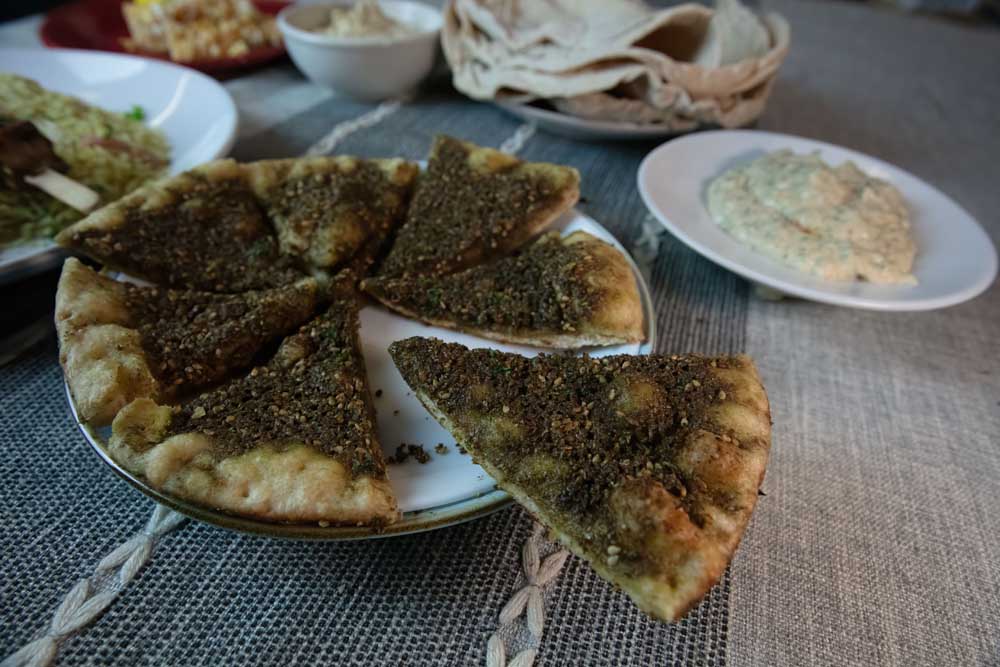The Mediterranean medley in Bend
Published 3:00 am Thursday, August 20, 2020

- Za’atar flatbread has a thick layer ofMiddleEastern spices at Kebaba.
What exactly is Mediterranean food? After all, many countries surround the Mediterranean Sea. While each of Bend’s Mediterranean restaurants serves many of the same menu items, their preparation can differ. Kebaba follows a more traditional Middle Eastern cuisine. Kefi Fast Fresh Mediterranean has Greek influences. Joolz is Lebanese.
The basic spices used are similar—oregano, thyme, marjoram, cumin. However, some regions use heavier allspice, cardamom, and za’atar. Cooking is done in olive oil. Meats include low-fat beef, chicken and lamb. Most Mediterranean restaurants will offer several vegetarian dishes like hummus, pita bread, falafels, and baba ganouj (pronounced gah-noosh). Hummus is blended garbanzo beans, spices, and tahini paste made from ground, hulled sesame seeds. Baba ganouj is a mixture of smokey eggplant and tahini. While they are made from the same basic ingredients, they don’t taste the same at different restaurants.
Pita bread for sandwiches and dipping into the hummus and baba ganouj can be thin, or fluffy and thick.
Along with tahini, tzatziki sauce is served with everything from falafels to lamb kebabs. Yogurt is the base of this sauce which may also have cucumbers, lemon juice, and mint, dill, parsley, thyme and oregano. Its light creaminess is a welcome refreshing contrast to the Middle Eastern fried or spiced food, especially falafels.
JoolzChef Ramsey Hamden grew up in Lebanon and brought the food of his youth to Joolz. Lebanese food is lighter than other Middle Eastern cuisines that use rich, strong spices. Hamden has brought recipes from his childhood that are “95% Lebanese” but with a Western influence. The restaurant’s tagline is “Where the Middle East Meets the Wild West.” Hamden explained, “The Lebanese gather around their meals so it’s very important to them to have a family. All their social gatherings are around the table. As soon they sit down, about 25 small plates are put on the table.” Joolz offers that tapas-style food sharing experience.
Hamden has been a culinary teacher, which is apparent in how he combines fresh, quality ingredients to create an excellent meal. This time we tried the lamb kebab entree, the falafel, and hummus. The lamb was mouth-watering—grilled on the outside and cooked to a tender medium-rare. The hint of mint in the tzatziki dipping sauce was the perfect compliment. It sat on top of a generous portion of subtlety flavorful turmeric rice. It came with Brussel sprouts, broccoli grilled to enhance their taste, and flash-fried cauliflower.
The falafels were large, nestled in thick pita bread. It came with a nutty, creamy tahini sauce and tzatziki that cut through the falafels’ heartiness. On the side, we got the hummus topped with garbanzo beans, garlic, and red pepper, which added spice to the lemony, nutty hummus, which I consider to be the best in town.
Kebaba
Owner Steve Koch opened Kebaba in 2006 when there were few ethnic restaurants in Central Oregon. He declared, “There wasn’t a falafel to be found.” Having traveled extensively in the Middle East, he wanted to bring to Bend some of the exotic dishes and flavors he ate there.
The base of Kebaba’s cuisine is from Levant countries. Jordanian, Israeli, Syrian, Turkish and Lebanese influences are brought together with Northwestern, Western, Greek and other flavors. Koch recognized that he would have to slowly introduce the exotic, intense flavors of this cuisine to Bend. He began by adding the flavors to a burger and fish and chips. Both have been so popular that they are still on the menu.
Currently, Kebaba is only serving takeout and delivery through GrubHub and Bend Takeout. We chose the “Create Your Own Feast” dinner for two to try several starters and entrees. It came with Za’atar flatbread. The pizza-like dough was covered with a thick layer of herbs. One of the dishes Koch enjoyed during his travels, the flavors and texture were entirely foreign. At first, it was like biting into a pile of dried herbs—oregano, thyme, and marjoram. Then I tasted the tanginess from sumac. It was spicy, salty, with nutty sesame seeds. A shock to my senses, I fought my resistance and had a second bite. That second bite was everything. I knew what to expect and could settle into all of the exciting flavors. By the time I finished my first piece, it was like eating potato chips. I couldn’t stop and craved more.
I particularly liked the wild Pacific salmon kebab with tandoori spice, grilled on the outside, and tender in. The Israeli couscous was another favorite. The lemon herb dressing, artichoke hearts, bell pepper, red onion, and roasted tomato added zing to the couscous that was tossed with feta to play off the sour. We also had the falafels and baba ganouj roasted eggplant dip.
Kebaba’s hummus has a different flavor and consistency than many that I’ve tried. It is creamier and more tahini forward than most others. Again, this is a style Koch brought back from the Middle East.
Kefi Fast Fresh Mediterranean
When I realized this was fast food, I was initially skeptical. But, from the first bite, I was pleasantly surprised. All of the food was light, fresh, and tasted healthy. It’s a great fast food choice for vegans and vegetarians. That was the goal of owner/chef Nick Stanitsas who was inspired by the Greek food he ate growing up. He’s expanded with the other Mediterranean and Middle Eastern dishes at Kefi. (Kefi means joy, high spirits, and a passion for food, dance, and life.) A passion that Stanitsas shows off in his offerings.
The Kefi Classic Gyro is their only sandwich with set toppings— tomatoes, onions, feta cheese, tzatziki sauce and french fries. Stanitsas explained that topping the Gyro with french fries is common in Greece and around Europe.
The rest of the menu is “build your own” entree. Start with brown rice, greens, pita bread, or a gluten-free wrap. Add a protein, toppings, and a couple of sauces.
I started with brown rice with parsley and lemon, which was fluffy and light. House-made (gluten-free) falafels came next. These are smaller falafels, but the creamy garbanzo bean center with fresh parsley, cilantro, red onion, garlic, cumin, and coriander, was a nice contrast to their crispy exterior.
Choosing my toppings, I thought of those things I’ve liked before and made sure to include salt, savory, sweet, sour flavors. Stanitsas got creative with toppings, offering pickled zucchini with fresh mint, and marinated golden beets. Both were a wonderful combination of tart and sweet.
We also ordered a Gyro on pita. The thick, soft pita was as good the next day as when I first ate it. I chose cucumbers, marinated golden beets, feta cheese, mixed olives, pickled zucchini and raw red onions and topped it with roasted garlic hummus sauce for a bit of savory and tzatziki sauce for creamy coolness.
It was educational to compare the differences between these three Mediterranean styles. I recommend you try it for yourself.








